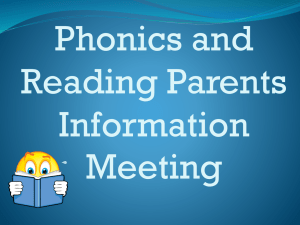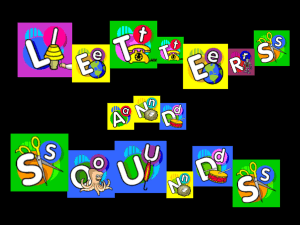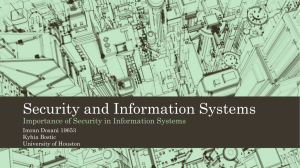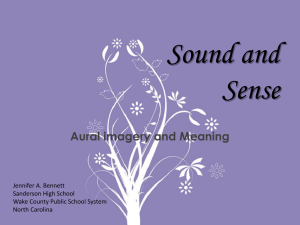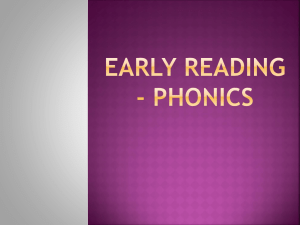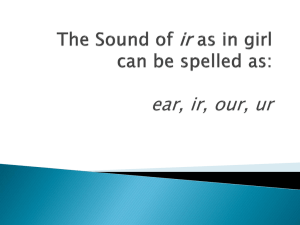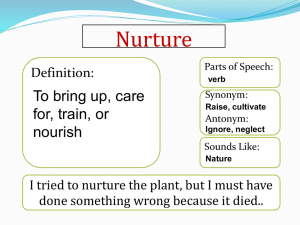Phonics Workshop ppt
advertisement
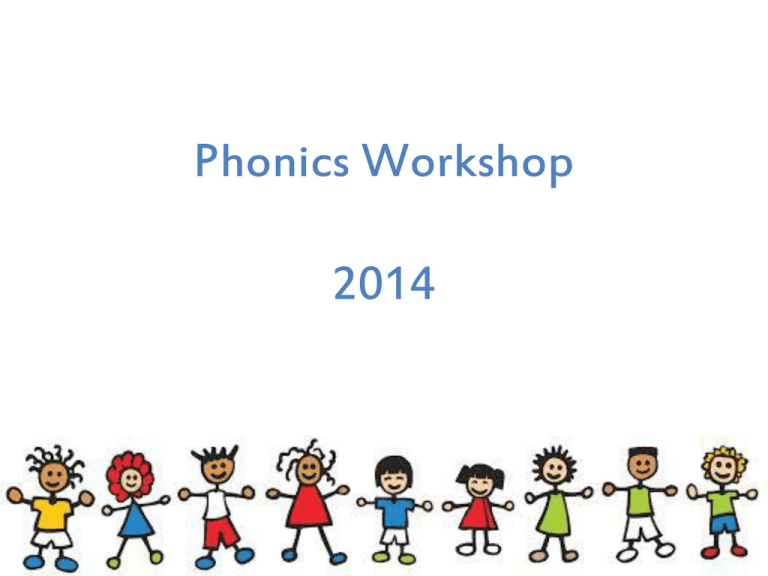
Phonics Workshop 2014 What is Phonics? •Tuning in to sounds- honing in on language •Learning letters and the sounds they make •Developing the skill of blending these sounds together to read words •Developing the skill of segmenting the sounds in a word and choosing the correct letters needed to spell it Progression Before children can become confident readers and writers they need to become confident listeners and speakers Phonics is structured following the ‘Letters and Sounds’ programme The children are taught progressively through ‘phases’ Phase One – Have fun with sounds – Listen carefully – Develop their vocabulary – Speak confidently to others – Tune into sounds – Listen and remember sounds – Talk about sounds – Identify similarities in the sounds of words e.g. rhyme and alliteration These are the FOUNDATIONS of becoming an articulate speaker, a fluent reader and a comprehensive writer Supporting Phase One at home (1) Discuss sounds they can hear in different places (2) Play sound pattern games- Clap and Copy sounds (3) Sing and change words familiar songs and rhymes (4) Read books with simple rhymes- Ask your child to listen for the rhyming pairs (5) Play rhyming games- say three words- “cat, apple, bat” can your child tell you which words rhyme? (6) Play segmenting games- “I think I can r-u-n” Take it in turns to MODEL and then let your child try (7) I spy games are great for this- I spy with my little eye... A b-u-s? (8) Practice counting the beats in words- Cro-co-dile, Jam- Sand-wi-ches Phase Two -To teach 19 grapheme-phoneme correspondences Set 1: s, a, t, p Set 2: i, n, m, d Set 3: g, o, c, k Set 4: ck, e, u, r Set 5: h, b, f, ff, l, ll, ss Each sound has an action to support recognition Phase Two -To move from oral blending and segmenting to blending and segmenting with letters -To read and spell VC and simple CVC words Segmenting Blending peg peg Phase Two To learn High Frequency Words is, it, in, at, and To learn Tricky words: the, to, I, no, go, into Phase Two To introduce reading words and simple captions pat a dog a cat in a hat a sad man a pin on a map pots and pans dad and nan a nap in a cot a kid in a cap a tin can cats and dogs a hug and a kiss on top of the rock a bag of nuts to huff and puff go to the log hut a hot hob sit back to back a red rug get to the top socks on a mat a cap on a peg a run in the sun a cat on a bed to the top of the hill get off the bus no lid on the pan pack a pen in a bag a doll in a cot a cat and a big fat rat rats on a sack a pup in the mud run to the den mugs and cups an egg in an egg cup Supporting Phase Two at home -Create a ‘thinking circle’ when sounding and blending: -Sound out simple words (VC/ CVC) using fingers: 1 finger = 1 unit of sound -Build words using flashcards which are both real and nonsense: bat fon sar pop cup bed tuw zup Cat- c – a – t - Cat Phase Three -To teach a further 25 graphemes: Most of these are digraphs (2 letters which make 1 unit of sound) or trigraphs (3 letters which make 1 unit of sound) Set 6: j, v, w, x Set 7: y, z, zz, qu Digraphs: ch, sh, th, ng, ai, ee, oa, oo, ar, or, ur, ow, oi, er Trigraphs: ear, air, ure, igh, Phase Three - Further blending and segmenting of CVC words – -Read and spell two syllable words and captions To read/spell (break it down) Add both parts together picnic picnic Phase Three -Learn to read more tricky words and spell some of these words he she we me be was you they all are my her A BIG emphasis on SPELLING I the no go to into Phase Three -Learn the NAMES of letters as well as the SOUNDS they make: A B C D E F G H I J K L M N O P Q R S T U V W X Y Z Supporting Phase Three at home -Make sure children know the difference between sounds and syllables: Example “apple” - apl ap-ple -Use an alphabet mat WHILE singing the song: lmnop is not one letter! Once confident reading tricky words, also practice writing them: the I, no, go, to, into Beginning to Read Language and communication skills are vital to a child’s emotional and personal development as they develop a sense of self and their relationship to others. Exposure to stories helps to enrich the imagination and provide knowledge of a range of experiences that a child can draw on to give them confidence in their daily life. Unsurprisingly, the more children read (or are read to) the more they are likely to achieve. The difference in achievement between children who read for half an hour a day and those who don’t is huge – as much as a year’s education by the time they are 15. Beginning to Read We assess the children each week in Robins as to their readiness for a reading book. It is counter productive to send home books when they are not ready for them. If you child is not yet taking home a school reading book, share books at home together, talking about the pictures and the story, looking at the letters on the page and ask questions such as “what might happen next” or “why do you think ____ is feeling like that?” Beginning to Read As your child approaches the time where they will begin to take a school reading book home, we have compiled a few “do’s” and “don'ts” to help you support them at home. We change the children’s books and hear them read on a MONDAY. Please write and sign their reading record book otherwise we will not change their book until the following week Reading at Home Do’s Keep reading enjoyable! Once your child begins taking a reading book home, they feel so grown up and proud!! Even if they haven’t mastered segmenting and blending, if the concoct a nonsense story or only recognise a few sounds in the book, praise praise praise!!! Keep it enjoyable, ask questions, read together and keep it short and it will all begin to progress. Reading at Home Do’s Complete the activities at the back The Dandelion Readers are a fantastic scheme as they help the children feel like successful readers. They also support your child’s understanding of WHAT they have read. Comprehension is the backbone of being an independent reader. If your child can read their book within 5 minutes then great, but if they don’t know what they have read, then they are not fully developing their skills as readers. Do’s Reading at Home Be honest in their reading record book. Don’t write ‘Read completely perfectly!’ if getting to the end of p1 was painstaking! We want to help your child become a fantastic reader, and if it’s not going well at home, but the feedback doesn’t tell us, both you and your child will find reading frustrating not fun! If your child is struggling and you need some helpful advice... Be honest, write it in the record book and we will support you as much as you need. Do’s Reading at Home Be honest in their reading record book. Don’t write ‘Read perfectly!’ if getting to the end of the first page was really tricky! We want to help your child become a fantastic reader, and if it’s not going well at home, but the feedback doesn’t tell us, both you and your child will find reading frustrating not fun! If your child is struggling and you need some helpful advice... Be honest, write it in the record book and we will support you as much as you need. Reading at Home Dont’s Do not force your child to read at home. We expect your child to have read their book at least once each week. We do not expect your child to have to read every night from one week to the next. They have extremely busy days at school and sharing bedtime story is just as effective at developing reading. Alongside their book, practice the High Frequency Words, Tricky Words or make words with their sound flashcards instead Beginning Writing Children often begin school with very ‘set’ ideas of themselves as writers. “I can’t” children- These children are ‘reluctant writers’. Somewhere along their journey prior to school they have learnt that they ‘can’t’ so they ‘don’t’ CAPITAL LETTER writers- These children have learnt to write in CAPITAL letters only. They find if very difficult to re-learn lower case letters and change their pattern of thinking ‘I don’t do those letters I do these’ Mark Makers- These children are happy to have a go at making marks- lines, dots, swirls and circles- they enjoy the process and are less concerned about the final outcome What we expect “She must be so behind- She said she’d written ‘adventure park’ but it was just scribbles!” Making Marks Initial Sounds “I can’t” It is MUCH harder to teach a RELUCTANT writer than a child that is MAKING MARKS At school we expect every child to “have a go” From making marks to using their phonic knowledge, we make sure ALL attempts at writing are valued Writing Progression (1) Initial Mark Making Adults usually describe this as ‘scribbles’ Lots of random marks, but child is unable to ‘give meaning’ to what they have done FIST GRIP (2) Initial Mark Making More purposeful motion to marks Attempts at closing shapes Combine shape and lines representing ‘a word’ BEGINNING TO PINCER GRIP (3) Initial Mark Making Copies an adults marks Works across the page Has a clearer idea of what marks they want to make May use either hand BEGINNING TO PINCER GRIP Writing Progression (4) Emergent Writing Makes individual marks May write some letters form name Understands writing and drawing are different Aware that print carries a message DEVELOPING CONTROL GRIP WITH DOMINANT HAND (5) Emergent Writing Forms symbols and some recognisable letters Beginning to write in horizontal direction Aware that writing conveys meaning- may ‘read’ what they have written DEVELOPING CONTROL GRIP WITH DOMINANT HAND Writing Progression (4) Confident Writing Writes using unfamiliar letters Uses some upper and lower case (not in correct places) Writes own name reliably CONTROLLED GRIP WITH DOMINANT HAND (5) Confident Writing Writes most letters correctly May use capital letters and full stops (not always correctly) Attempts to write for a purpose- letters and lists Can read back what they have written CONTROLLED GRIP WITH DOMINANT HAND Writing at home Do’s (1) MODEL writing at home- Spend time with your child while you write your shopping list, send an email, write a birthday card. The more they SEE writing, the more they will understand it’s PURPOSE (2) Make sure they have ACCESS to paper, pens, pencils, envelopes etc- don’t just keep these as ‘rainy day’ resources (3) VALUE any mark making your child does at home. Stick things on the fridge, keep things to show relatives and friends- if you’re proud, your child will feel proud Don’t Writing at home (1) DOTTY LETTERS- this makes children develop a very disjointed way of writing and actually causes more problems than it solves If your child wants your help, write it on a scrap of paper and they can look at this while they write freely on another piece (2) UPPER CASE- It takes a longer for children to develop effective writing skills when they learn capital letters first. Stick with lower case letters (except for at the start of a sentence and names) (3) I CAN’T READ IT- Comments like “I can’t read it!” “I don’t know what you’ve written” are quick to say and so easily knock confidence. Instead try “I wonder what you’ve written?” “Can you tell me all about it?” Glossary -Grapheme- How a letter LOOKS -Phoneme- How a letter SOUNDS -Segmenting- Breaking up a word into units of SOUND -Blending- Joining up units of sound to make a whole WORD -VC word- Vowel, Consonant -CVC word- Consonant, Vowel, Consonant - High Frequency Words- Common words used in reading and writing -Tricky Words- Cannot be segmented. SIGHT WORDS Thank you Thank you for coming today Please have a look through the examples of resources and games for supporting Phonics at home. The Phase 1 packs can be taken home (1 per child) to play. The box will be available after school everyday for you to come and change your pack Please sign your pack out and back in again! If you have any questions please come and see me


